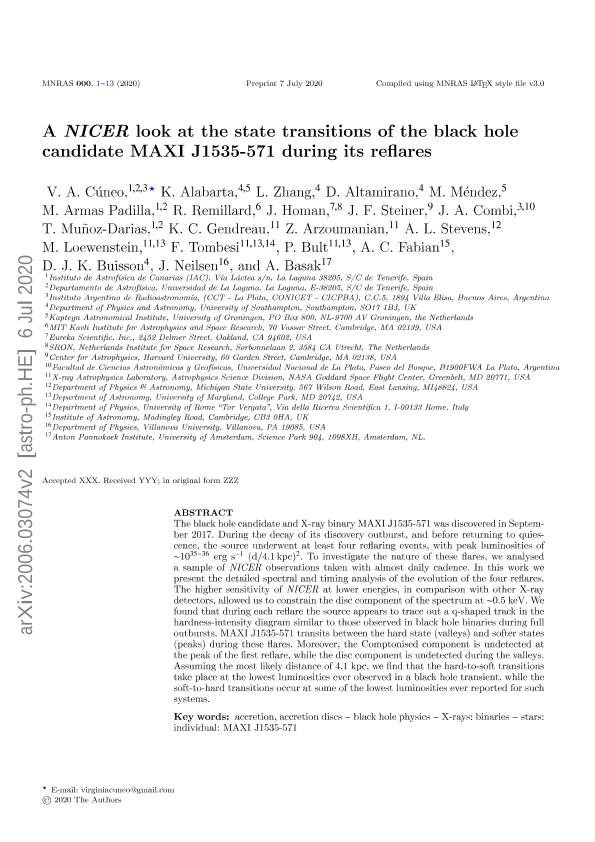Artículo
A NICER look at the state transitions of the black hole candidate MAXI J1535−571 during its reflares
Cuneo, Virginia ; Alabarta, K.; Zhang, L.; Altamirano, D.; Méndez, M.; Armas Padilla, M.; Remillard, R.; Homan, J.; Steiner, J. F.; Combi, Jorge Ariel
; Alabarta, K.; Zhang, L.; Altamirano, D.; Méndez, M.; Armas Padilla, M.; Remillard, R.; Homan, J.; Steiner, J. F.; Combi, Jorge Ariel ; Muñoz- Darias, T.; Gendreau, K. C.; Arzoumanian, Z.; Stevens, A. L.; Loewenstein, M.; Tombesi, F.; Bult, P.; Fabian, A. C.; Buisson, D.J.K.; Neilsen, J.; Basak, A.
; Muñoz- Darias, T.; Gendreau, K. C.; Arzoumanian, Z.; Stevens, A. L.; Loewenstein, M.; Tombesi, F.; Bult, P.; Fabian, A. C.; Buisson, D.J.K.; Neilsen, J.; Basak, A.
 ; Alabarta, K.; Zhang, L.; Altamirano, D.; Méndez, M.; Armas Padilla, M.; Remillard, R.; Homan, J.; Steiner, J. F.; Combi, Jorge Ariel
; Alabarta, K.; Zhang, L.; Altamirano, D.; Méndez, M.; Armas Padilla, M.; Remillard, R.; Homan, J.; Steiner, J. F.; Combi, Jorge Ariel ; Muñoz- Darias, T.; Gendreau, K. C.; Arzoumanian, Z.; Stevens, A. L.; Loewenstein, M.; Tombesi, F.; Bult, P.; Fabian, A. C.; Buisson, D.J.K.; Neilsen, J.; Basak, A.
; Muñoz- Darias, T.; Gendreau, K. C.; Arzoumanian, Z.; Stevens, A. L.; Loewenstein, M.; Tombesi, F.; Bult, P.; Fabian, A. C.; Buisson, D.J.K.; Neilsen, J.; Basak, A.
Fecha de publicación:
06/2020
Editorial:
Wiley Blackwell Publishing, Inc
Revista:
Monthly Notices of the Royal Astronomical Society
ISSN:
0035-8711
Idioma:
Inglés
Tipo de recurso:
Artículo publicado
Clasificación temática:
Resumen
The black hole candidate and X-ray binary MAXI J1535−571 was discovered in 2017 September. During the decay of its discovery outburst, and before returning to quiescence, the source underwent at least four reflaring events, with peak luminosities of ∼1035?36 erg s−1 (d/4.1 kpc)2. To investigate the nature of these flares, we analysed a sample of NICER (Neutron star Interior Composition Explorer) observations taken with almost daily cadence. In this work, we present the detailed spectral and timing analysis of the evolution of the four reflares. The higher sensitivity of NICER at lower energies, in comparison with other X-ray detectors, allowed us to constrain the disc component of the spectrum at ∼0.5 keV. We found that during each reflare the source appears to trace out a q-shaped track in the hardness?intensity diagram similar to those observed in black hole binaries during full outbursts. MAXI J1535−571 transits between the hard state (valleys) and softer states (peaks) during these flares. Moreover, the Comptonized component is undetected at the peak of the first reflare, while the disc component is undetected during the valleys. Assuming the most likely distance of 4.1 kpc, we find that the hard-to-soft transitions take place at the lowest luminosities ever observed in a black hole transient, while the soft-to-hard transitions occur at some of the lowest luminosities ever reported for such systems.
Archivos asociados
Licencia
Identificadores
Colecciones
Articulos(IAR)
Articulos de INST.ARG.DE RADIOASTRONOMIA (I)
Articulos de INST.ARG.DE RADIOASTRONOMIA (I)
Citación
Cuneo, Virginia; Alabarta, K.; Zhang, L.; Altamirano, D.; Méndez, M.; et al.; A NICER look at the state transitions of the black hole candidate MAXI J1535−571 during its reflares; Wiley Blackwell Publishing, Inc; Monthly Notices of the Royal Astronomical Society; 496; 2; 6-2020; 1001-1012
Compartir
Altmétricas



